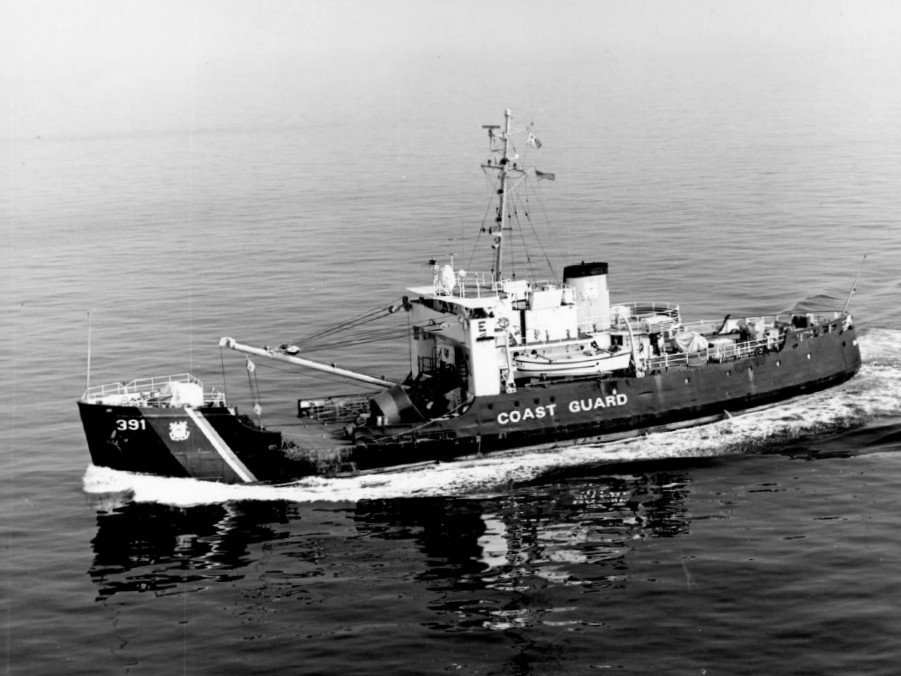From the Masthead
The ship lays on her side, in shallow water. The diver swims inside, enters the passageway and stands on the bulkhead opposite the chart room hatch (Coast Guard speak for door) and pushes against it with all his might. It will not yield, he’s unable to enter the space and is forced to move on in his search for other victims.
Later on, when the ship is raised, he re-enters the hulk to assist in the removal of the bodies. He also examines the reason for the recalcitrant hatch. In seagoing vessels, all heavy gear is bolted to the deck, or at least it’s supposed to be. For some reason, however, a filing cabinet in this space was kept in place by its own weight alone; this defect went unnoticed, a catastrophe lying in wait, for years, possibly decades (the ship was built in 1943, and had just completed a major refit), until the collision. When she was pulled onto her beam-ends by the merchant ship’s anchor, which was embedded in her hull, the deadly filing cabinet slid across the compartment and lodged against the hatch, trapping the hapless crew-member in what would become his tomb. One can only imagine what that sailor’s last thoughts may have been.
For vessels that go to sea, recreational, commercial and military alike, even those that typically don’t venture out of sheltered waters, unsecured gear, furniture, tools, equipment etc. is a potential hazard. In a recent vessel inspection, I encountered a large bank of batteries, which weighed over 800 lbs. collectively, that were simply strapped together, rather than being secured to the vessel itself. In tumultuous conditions such loose gear is a recipe for disaster.
Conduct a gear security check of your vessel, ask yourself what would happen if the vessel heeled 20°, 30°, 45°, or for a blue water vessel 90°. What would come adrift, what would become a missile, striking other equipment, seacocks, or personnel, what might lodge against a hatch or door?
This month’s eMagazine feature article, written by guest author Dick Stevenson, covers the subject of anchor rode selection. I hope you find it both interesting and useful.
Choosing Chain: Challenging a Maritime Myth
Written by Dick Stevenson
Photos by Steve D’Antonio © 2019
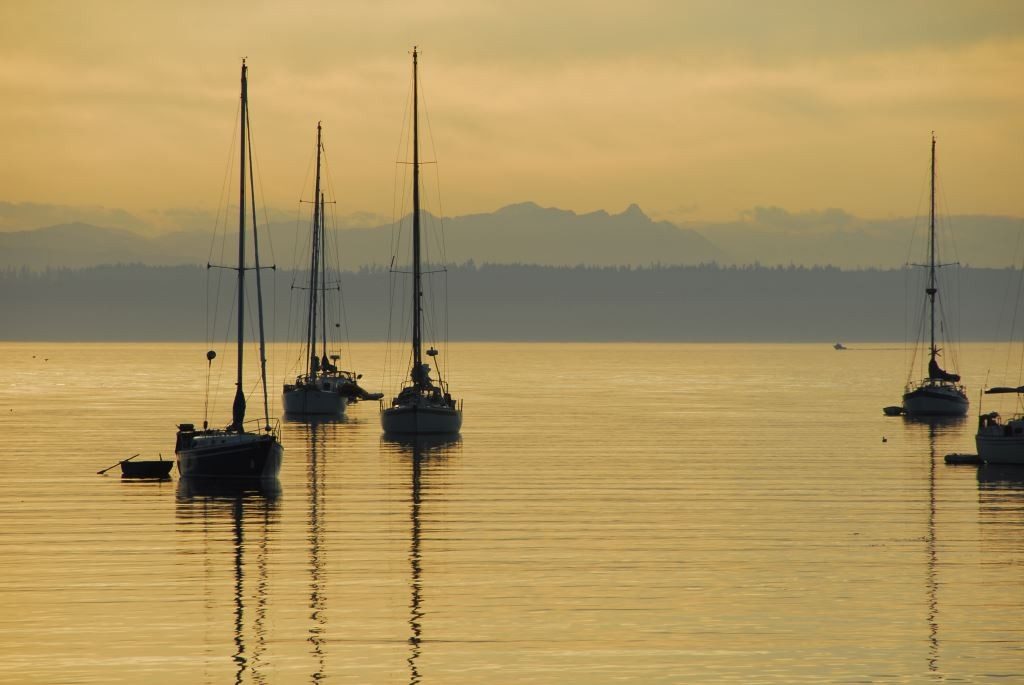
Catenary comes into its own in benign conditions, when it’s needed least.
Anchoring techniques and equipment are evolving and becoming more effective. Recently the new generation of anchors are proving far better at setting and staying set, especially in marginal conditions of adverse seabed and shorter scope. However, the effectiveness of a ground tackle system is still in the details. The “myth” I wish to explore/challenge is one that is repeated frequently in magazine articles and books as well as on the docks and bar stools where sailors congregate. The myth, in ground tackle lore, holds that the catenary resulting from using chain (the arc of the rode from bow to anchor, resulting from the weight of the chain), is important to ground tackle functioning.
In my experience, however, catenary is most effective when it matters least and all but disappears when it matters most. The case for catenary is that it absorbs forces, gusts and large seas, and averages them out so the anchor only experiences average forces and is protected from shock loads. In the following, I will suggest that chain be chosen with strength being the major consideration, and that chain weight (and its resultant catenary) contributes far less to staying attached to the seabed than is usually thought to be the case. I will also suggest where to place weight so that it does contribute to ground tackle effectiveness.
Ground tackle, in its major components (anchor, chain and snubber), serves only one function: to keep your boat attached to the bottom. In benign and even moderate conditions, it matters little what you use or how you use it. It is in when wind and waves increase that the details of those bits and pieces matter. Since every boat’s performance is compromised by weight in the bow (especially sailboats) every boat owner has a limited amount of weight to put into a ground tackle system. So, owners struggle with what weight anchor and chain to buy. No one wants to hobble their boat’s performance, but we also really want our boat to stay put when we set the anchor down. We rightly cringe at the thought of going walk-about, with the anchor dragging, in a crowded or rocky anchorage at night. Bigger chain just looks and feels much stronger and safer.
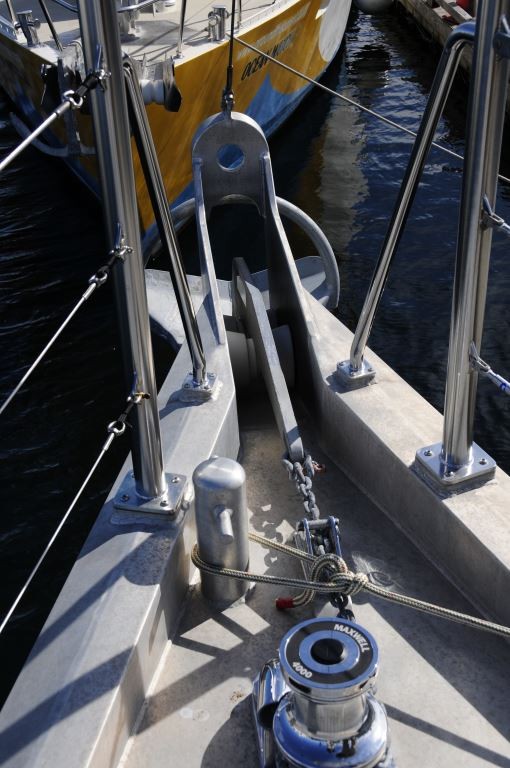
If you are going to add weight to your ground tackle, it’s best added to the anchor rather than the chain; while chain should be selected for maximum strength.
The arguments for heavy chain weight being an important factor largely rely on three related considerations: that more weight provides more shock absorbing catenary; that this additional weight helps sink the chain to the bottom, resulting in a superior angle of attack, anchor to sea bottom; and that larger chain is stronger.
Let us look at these arguments. In light to medium airs, after getting your anchor a good stick in the sea bottom, you are really unlikely to have any troubles. The weight of chain is keeping you quite comfortable and the snubber has little work to do. The angle of attack of the anchor to the seabed is as good as it gets as the chain leading to the anchor is lying on the bottom. No element of the system is being challenged in the slightest. This picture matches the oft seen diagram portraying catenary in the books and magazine articles on anchoring: the one showing a boat at anchor with a lovely loop arcing from bow to the anchor on the seabed. This diagram illustrates a great deal of shock absorbing catenary and a superb angle of attack for the anchor with the bottom. The boat in this diagram looks to be in about 15 knots of wind, just enough to stretch the chain out a bit, and would apply, with the usual suggested scope for chain, into wind speeds in the 20s, depending on the protection from the seas.
Now let’s look at what occurs when the weather gets more boisterous.
Observation of my boat (40 foot, sail) and the boats anchored around me is that the diagram just mentioned above changes dramatically. No longer is there a lovely energy-absorbing protective catenary arc. It seems apparent that, for every recreational vessel I have observed, power or sail, there are regularly occurring times when the rode becomes bar-tight. By this I mean the chain is pulled link to link till it is very close to straight, bow to anchor. This occurs in boisterous conditions not so much from sustained wind or even the build-up of seas; catenary disappears when the extremes of each coincide, a statistically predictable event that is in the “when it happens” rather than the “if it happens” realm. A gust catches the boat side-to and some bigger waves appear. The boat at first slides aft, then rears back with the wave and the chain is pulled taut. The danger, of course, is that the anchor will be snatched out of the bottom from the shock load. Moreover, again my observation, the size of the chain seems not to make appreciable difference. Most of my observations are of 5/16 or 3/8-inch chain with an occasional larger chain on neighboring boats; the first two sizes are the most likely considerations for boats in the 35-45 foot range. Regardless of these reasonable chain sizes, the rode become bar-tight in Near Gale (28-33 knots) to Gale (34-40) conditions.
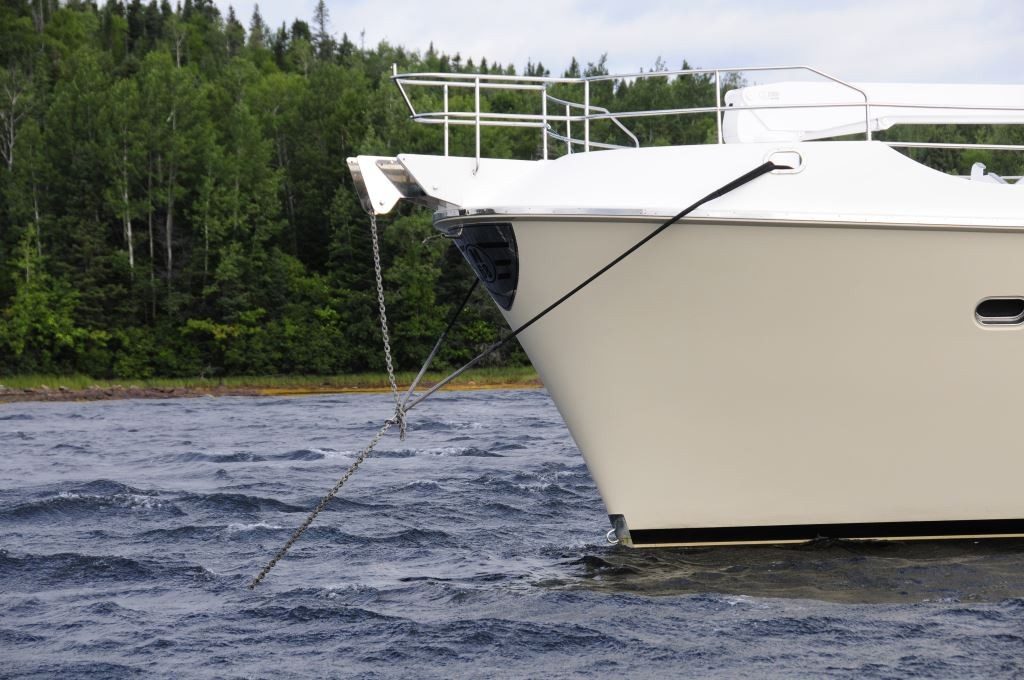
It doesn’t take much wind to pull this expedition trawler’s chain bar tight, even in a protected anchorage. It is here that a properly designed and deployed snubber system demonstrates its value.
Most of us anchor with the weather forecast in mind. It is when you go to sleep expecting a merely unsettled night but wake to find that you have sustained winds in the 30 kt range or, perhaps, an unexpected squall, that anchoring successfully shows its dependence on all its pieces working well together. As the wind increases, if you have the rare good fortune to be able to veer more rode, maybe lots more rode, you can continue to have the chain catenary absorb much of the shock loading and ensure that the anchor’s angle of attack to the sea bottom is adequate to the task. More often there are constraints– other boats, the shore, or an anticipated wind shift– so that veering more rode is not workable. Just when you need catenary most for shock absorption, it disappears.
In short, it has been my observation that Near Gale or Gale force winds provide the wind and sea conditions to regularly make the chain fully taught at most reasonable scope ratios and at any reasonable chain weight that cruising boats might carry. It follows then that the chain’s catenary’s shock absorption properties, just at the moment they are most necessary, are quite (or completely) compromised*. Your anchor’s best chance to stay in place is the snubber’s ability to absorb and average out the forces. The worst case would be that there is no snubber and the chain is held by the windlass (brake on); the load, now a shock load, is transferred directly into the windlass at one end and directly into the anchor at the other, an excellent recipe for dragging anchor or for a broken chain or broken windlass. At this peak load moment, the boat is in the most danger of snatching the anchor out of the bottom and beginning to drag.
You can’t do anything about the wind and the waves and, upon occasion, they will definitely give your rode a really sharp strong jerking tug. What is in your control is a method to average out the stresses on the rode. We have just been discussing how, at these more extreme times, relying on your chain catenary to average forces is a false hope. Now is when a stretchy snubber is an anchor’s best friend. (for more details on snubbers see my earlier writing: “Where the Devil Resides” in Steve D’Antonio’s SDMC Guide to Marine Systems Excellence, September 2012.
When the boat rears back, the snubber can make sure that the huge increase in rode load is averaged out as much as is reasonable. This decreases the peak load transferred to the anchor thereby minimizing the anchor shaft lifting off the bottom: essential to keeping the anchor in the seabed and our boats in place.
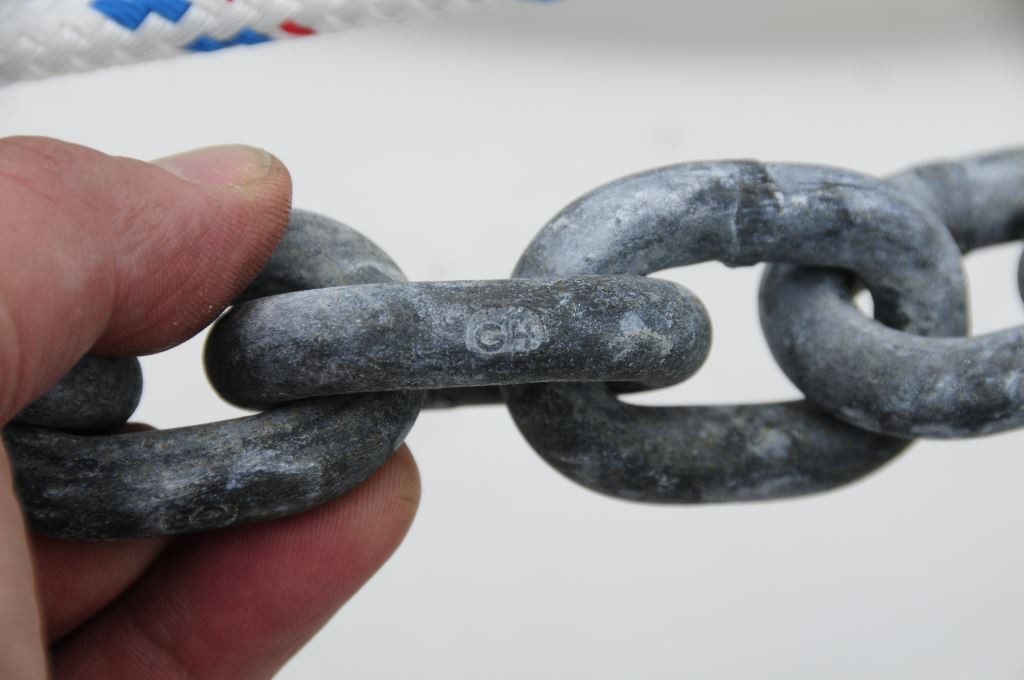
G4, G40 or G43 is among the most popular grade of chain, it offers a good balance of strength to weight.
This would lead to the following thoughts and suggestions:
- That the strength of chain should be the primary consideration (assuming good manufacture) when choosing chain and the weight of the chain secondary (or not a consideration at all). For example: in a choice between 5/16 inch HT (high tensile G4) chain where the SWL (safe working load) is 3900 lbs and 3/8 inch PC (proof coil) where the SWL is 2650 lbs. choose the 5/16 every day even though the 3/8 inch is heavier. The 5/16 inch HT chain is far stronger and is about 30% lighter in weight, both good things. For 250 feet of chain that would be almost 120 lbs weight savings difference in your bows and no decrease in ground tackle effectiveness.
- That when it comes to deploying weight in your ground tackle system, weight is better put into the anchor than in the chain. Weight in the anchor is significantly more effective at keeping your anchor in the seabed than weight anywhere else in one’s ground tackle. For many this might mean buying the next or even 2nd size larger anchor (consider having your “storm” anchor being your everyday bower, probably only a 10 pound /5kg weight gain per jump larger): the added weight does still not even come close to exceeding the potential weight savings outlined above and your sleep security will increase impressively.
- An additional consideration: it has been argued (in Practical Sailor, Feb, 2014) that smaller chain contributes to anchor penetration (smaller size allows deeper anchor penetration into the seabed), although I suspect that its role is small in ground tackle effectiveness.
- It might also be argued that lighter chain may allow more recovery (bounce forward) between gusts allowing a longer period for the boat to gain momentum and more hunting about before fetching up on the rode when the next gust arrives. This rearing back creates a type of yo-yo effect which could be a more dangerous scenario than sustained winds. The same might also be said for a too stretchy snubber.
- After scope, the next factor in importance in keeping the anchor stuck to the bottom is averaging out the fluctuating forces thereby flattening out the peak loads. Chain weight does a good job with this function in light to moderate breezes until it meets forces that bring it close to full stretch when it has no more “give” to give. Another way of saying this is that chain weight is very helpful when you need it least but when winds and seas become a challenge, the chain transfers loads directly and absorption is minimized. This means…
- That one’s snubber should be stretchy, probably stretchier than many allow for. Good stretchiness comes with small diameter line, longer lengths, and 3 strand nylon: combining all three gives the most stretch. Every vessel needs to find their optimal combination. See the above-mentioned article for more detail; for now, let me use my 40 foot 16 ton sailboat, Alchemy, as an example. I use a single 35-foot (10 meter) nylon 3 strand 7/16 inch (11mm) snubber which has held Alchemy for years without problem in most anchoring situations. The only time it was not deployed was in preparing the boat for a hurricane where I went with a bridle and larger diameter 3 strand (larger diameter was not exclusively for strength reasons, but for increased chafe protection). Nylon is impressively strong for its size, often exceeding the far stronger looking chain. Chafe is the only real issue to watch out for. I would wish for those with short snubbers, larger diameter snubbers (dock line size), or non-nylon snubbers to reconsider. (Please note: hurricane preparation has unique elements; it can be thought of more as making a mooring than it is anchoring, and mooring pennants should be of quite different materials/construction than anchoring snubbers.)
- Finally, for those whose cruising grounds have them anchoring deep, lighter chain allows you to carry a significantly longer rode for the same weight/space. This can make a big difference when you are looking at 60-80 foot depths and katabatic gusts falling on your vessel out of the mountains.
Safe anchoring to all, Dick Stevenson, s/v Alchemy, Stornoway, Scotland
- *The same might be said for weights, kellets/sentinels, hung from either chain or rope rode to augment catenary. In a blow, with the rode jumping about, I could see them being a distinct liability: chafe or entanglement and/or damage to self or boat: in any case, no longer contributing to the anchor staying in place.
Dick Stevenson is a retired Clinical Psychologist/Psychoanalyst who, with his wife Ginger, a former teacher, have made their home aboard their cutter Alchemy, a Valiant 42, for most of the last 16 years. They started with 25 years of cruising the NE United States (Bermuda to Maine) with their 3 children. In 2002 they retired, sold the house, and moved aboard full time. They have wandered in Central America, Bahamas, and parts of the eastern Caribbean. They crossed the North Atlantic in 2006 with stops in Bermuda and the Azores and spent 4-5 seasons in the Mediterranean: the usual Med cruising grounds, but were also fortunate enough to sail to Syria, Lebanon, Israel and Egypt. After years in warm climates, they sailed to Northern Europe where they had the joy of sailing as far east as St Petersburg, Russia and above the Arctic Circle in Norway. Five years was not nearly enough time for these Northern European waters, but being closer to family was beckoning so this last season they crossed the North Atlantic cruising the Faroe Islands, Iceland and Greenland before fetching up in Newfoundland, Canada.
Editor’s note; there are times when there’s no substitute for weight. The bulk of my experience is aboard displacement expedition motor vessels, where added stored rode weight isn’t so much of a concern. While cruising in Greenland a few years ago I made for an anchorage, it was an all-day trek to get there. This passage from my log of the passage sets the stage, “By 1900 we reach the inland passage we intend to take, through a series of fjords; the plan is to anchor in one of them for the evening. This narrow rift, between the mainland and Nunarssit Island, provides a route that is both protected and picturesque. The entrance is called Ikerasatsiaup Nuna, the walls are sheer and the width narrow, half a mile keyhole through which we pass; the water’s depth is over 900 feet in places.”
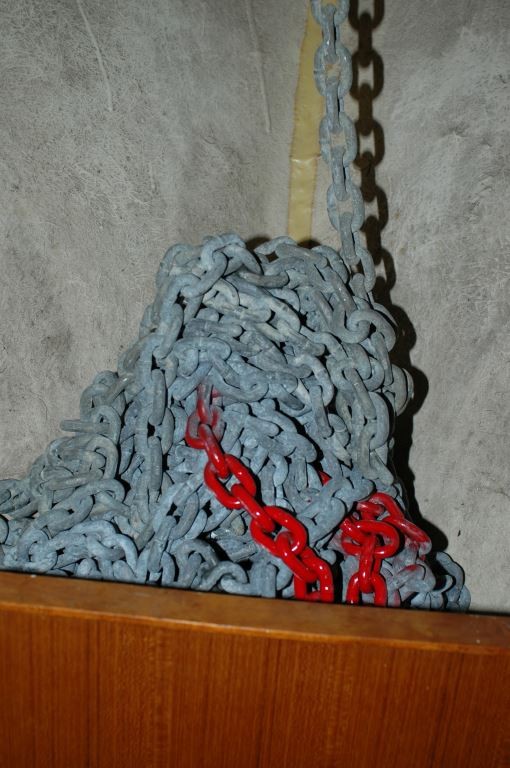
In most cases rode length is a function of available storage area, as well as the desire to limit weight stored in the vessel’s ends.
When we arrived at the intended anchorage it was dusk (and thus very late for southern Greenland in summer), and a terrible time to anchor, and there was no reasonable nearby alternative anchorage, again less than ideal. We were of course alone, nothing ashore and no other vessels around, and the crew of three were very tired as we’d all been getting less and less sleep in those high latitudes; it’s a scenario familiar to anyone who has cruised or lived in these regions, you go to sleep later and later and get up earlier and earlier. We dropped the 150kg Rocna and paid out 200 feet of rode in about 30 feet of water, the inlet was surrounded by rocky low hills, as black as obsidian, and winds were gusting to about 30 kts, although the waters were protected, the hills offered scant protection, the passes between them were actually funneling the wind at times. When we backed down the anchor simply dragged along the rocky bottom, we repositioned and tried a few more times but it simply would not set. To make matters worse we were off the chart, literally, our cartography for this region ended about a third of the way into the inlet. Our alternative was to keep going to the next anchorage, in the darkness, through this narrow inland passage, one that’s considered somewhat risky in daylight. As tired as we were, and as dangerous as that prospect was, we were very reluctant to once again get underway. The vessel’s master decided to drop the anchor in the middle of the inlet and pay out 350 feet, literally a ton, of rode, and its weight and friction on the rock bottom held us firmly in place overnight. I think we all slept fitfully, periodically getting up to check the GPS plot to see if we were dragging; we didn’t. Without the heft of that chain, we would have been up the proverbial creek.

